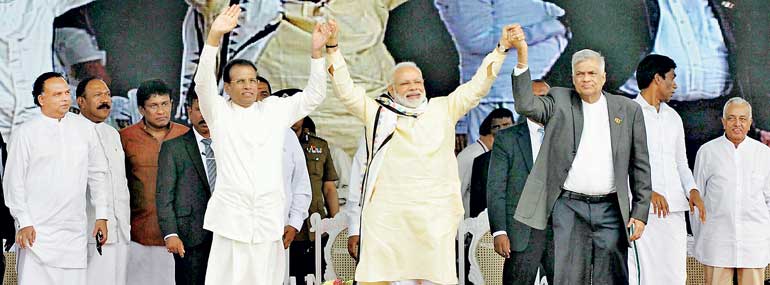Thursday Dec 12, 2024
Thursday Dec 12, 2024
Saturday, 20 May 2017 00:00 - - {{hitsCtrl.values.hits}}
 India’s Prime Minister Narendra Modi joins hands with President Maithripala Sirisena and Prime Minister Ranil Wickremesinghe on stage during the public rally in Norwood, Hatton on 12 May – Pic by Ruwan Walpola
India’s Prime Minister Narendra Modi joins hands with President Maithripala Sirisena and Prime Minister Ranil Wickremesinghe on stage during the public rally in Norwood, Hatton on 12 May – Pic by Ruwan Walpola
By Meera Srinivasan
The Hindu: Prime Minister Narendra Modi’s public rally on 12 May with Sri Lanka’s hill-country Tamils, on the second day of his two-day visit to the country, was a success, if you went by conventional markers such as the crowd he drew or the cheers that arose from it. But its real outcome is rather limited compared to the wide-ranging needs of the historically neglected community.
That an estimated 35,000 people from in and around the central highlands converged on the small town of Norwood – many walking over 5 km since buses clogged the narrow roads — partly reflects the affinity the Tamils feel for India, from where their ancestors moved to Sri Lanka about 200 years ago. Moreover, hill-country politicians put in their might to mobilise workers, campaigning widely across the tea estates that employ a fourth of the over one million-strong community.
Modi’s visit to the region, the first by an Indian Prime Minister, was a strong affirmation of the community’s economic and political significance. In Sri Lanka’s key 2015 presidential elections, hill-country or Malayaha Tamils decisively voted for the President Maithripala Sirisena-Prime Minister Ranil Wickremesinghe opposition combine that ousted the authoritarian Mahinda Rajapaksa regime.
A story of neglect
Hill-country leaders who met Modi sought greater assistance in education, which remains a crucial need. Most estate schools lack teachers for mathematics and science, limiting higher education and employment choices for students. While Sri Lanka takes pride in its public health delivery and indicators, services in plantation areas are woefully inadequate. The India-funded hospital he inaugurated is no exception. Short-staffed and overburdened, it is struggling to serve the local community.
Indian assistance to a deprived region is certainly welcome but, at best, can only supplement what Sri Lanka ought to deliver to a forgotten people.
Several decades of neglect by the plantation companies and the state, that earned huge profits and export revenue from the estate workers’ cheap labour, have pushed hill-country Tamils to the margins of society. Northern Tamils underplay their sacrifices in the armed struggle, forgetting that many of the Liberation Tigers of Tamil Eelam cadre who died in the final offensive in May 2009 were those who migrated from the hill country.
Often quick to empathise with the northern Tamils, Tamil Nadu politicians are never heard speaking for Malayaha Tamils, who came from the State to work in British-owned plantations. Even New Delhi’s attention to these Sri Lankans — of most recent Indian origin — seems an afterthought, and coincides with their growing political clout.
After decades of struggle over citizenship and the largely patronage-style politics of the Ceylon Workers’ Congress (CWC) that traditionally represented them, the community has hardly escaped its exclusion. The highly politicised trade unions have weakened as the estate labour force has shrunk.
A widespread wage struggle last year was defused by companies that ultimately had their way. Even as a professional and business class emerges from the community, many women plantation workers are migrating to West Asia to work as domestic help, for meagre wages in highly exploitative conditions. Some return home only in coffins.
Slow political steps
In their 2015 vote, hill-country Tamils made an important political shift, breaking away from the CWC that supported Rajapaksa, and backing younger leaders from new parties who formed the Tamil Progressive Alliance (TPA).
Now Ministers in the Government, they have been vocal in their disappointment over slow progress on many fronts, including post-war reconciliation with minorities and a political solution to Tamil grievances. Notably, they are eager to position Malayaha Tamils as national player, like the majority Sinhalese, minority Tamils of the north and east, and Muslims.
It will take substantial political commitment from the government to deliver what is due to this community and bridge the gap between the hill country and the rest of the island. Last December, the cabinet decided to provide seven perches of land to estate residents — a belated but important step to address their landlessness.
India too has offered to build 14,000 houses, a drop in the ocean of the nearly 160,000 homes the community needs. Acknowledging the estate sector as “most deprived”, the National Unity Government unveiled an ambitious National Plan of Action for the Social Development of the Plantation Community (2016-2020), but what it will do with it remains to be seen.
Given the task ahead and the limits to what an external actor can do, the euphoria around Modi’s visit not only appears misplaced but also has the danger of reinforcing hill-country Tamils as passive beneficiaries rather than rightful citizens.
When he addressed Malayaha Tamils at the Norwood grounds, he hailed them as the “indispensable backbone of Sri Lanka”. Quoting a couplet from the Thirukkural, he assured them: “Wealth will find its own way to the man of unfailing energy and efforts”. Clearly, he missed the irony of saying this to a community whose toil and tears have been unrewarded for two centuries.